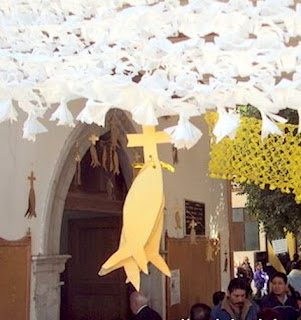Little now remains of the grand Franciscan monastery of The Assumption that once dominated the city center of Toluca.
Founded in the 1550s as the hub of a network of missions in the region, the convento served to prepare the friars for evangelizing the various indigenous peoples of the highland border region between the former Aztec and Tarascan empires: Nahuas, Otomís and Matlatzincas.
The primitive church and its convento were expanded and rebuilt in part over the centuries, notably in the early 1700s under Fray José Cillero, the energetic Guardian of the Toluca convento, when the Third Order chapel and the freestanding sacristy (La Capilla Exenta) were completed.
 |
| The Franciscan convento of The Assumption in 1834 |
Unfortunately, during the 1800s most of the monastery lands were sold or encroached on, and eventually the principal buildings demolished to make way for a neoclassic "cathedral" and arcaded marketplace.
Today the only remnant of the colonial monastic complex is the former sacristy, hidden away in an interior courtyard.
La Capilla Exenta exterior in 2012
La Capilla Exenta
This extraordinary octagonal Sacristy, added to the rear of the church of La Asunción and completed in 1729, is the first documented work by the innovative baroque designer and architect Felipe de Ureña— his only documented project in the Toluca area, where he was born into an established family of retablo designers and fabricators.
While the extent of his involvement in the architectural planning of the Capilla is uncertain, the interior design is entirely Ureña's. Probably on the drawing boards by 1727, when the architect was only 30, this ambitious project was a remarkable achievement for the time: sophisticated, innovative and amazingly complete in design and execution—a characteristic hallmark of all Ureña's projects where he was able to exercise full artistic control.
The unusual octagonal central plan of the Sacristy was its first innovation, an architectural feature that, although common in the Old World, was still rare in New Spain. Revolutionary for the time, it predates Lorenzo Rodríguez' influential, centrally planned Sagrario Chapel of the Metropolitan cathedral in Mexico City by several years.
La Capilla Exenta interior views in 1730 *
Large concave niches with arched openings around tall windows were cut into 7 of the 8 sides of the Sacristy (the doorway occupied the 8th) Detached estípite columns, now missing, formed the freestanding outer columns, and ornamental pilasters framed the windows, marking the earliest and boldest use of this signature, late baroque form by a Mexican designer.
 |
| La Capilla Exenta interior niche in 2012 |
In recent years the Capilla has been restored and the interior refurbished as a monument to the history of the monastery, its designer Felipe de Ureña and other eminent Tolucans.
 |
| La Capilla Exenta, the restored dome in 2012 |
* In 1730, the Franciscan chronicler Antonio Diaz del Castillo published an official commemorative folio, entitled "Mano Religioso del M.R.P. Fr. Joseph Cillero en la obra de la sacristía y altares del Convento Franciscano de Toluca.." which included a detailed description of the building and its furnishings with detailed engravings by Francisco Silverio, the only pictorial record of the original building interior.
text and color images © 2020 Richard D. Perry
Other sources:
Nicolás León, El Convento Franciscano de la Asuncion de Toluca. Mexico 1969
Richard D. Perry. De Valiente Fantasia. Felipe de Ureña (1697-1777) Master of the Mexican baroque (forthcoming)


















































